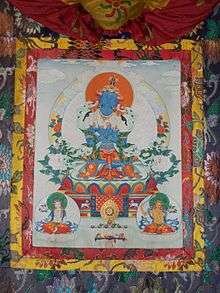Adi-Buddha
| Part of a series on |
| Vajrayana Buddhism |
|---|
 |
|
Traditions Historical traditions:
New branches:
|
|
History |
|
Pursuit |
|
Practices |
|
Festivals |
|
Ordination and transmission |
|
|

In Vajrayana Buddhism, the Adi-Buddha (Tibetan: དང་པོའི་སངས་རྒྱས།, Wylie: dang po'i sangs rgyas, THL: Dangpö Sanggyé ), is the "First Buddha" or the "Primordial Buddha."[1] The term reemerges in tantric literature, most prominently in the Kalachakra.[2] Ãdi means "first", such that the ādibuddha was the first to attain Buddhahood.[2] Ādi can also mean “primordial,” not referring to a person but to an innate wisdom that is present in all sentient beings.[2]
In Tibetan Buddhism, the term ādibuddha is often used to describe Samantabhadra, Vajradhara or Kalachakra.[2][3] In East Asian Mahayana, the ādibuddha is typically considered to be Vairocana.[2]
The Guhyasamāja Tantra says of Vajradhāra, "Then Vajradhara, the Teacher, who is bowed to by all the Buddhas, best of the three diamonds, best of the great best, supreme lord of the three diamonds[.]"[3]
Alex Wayman notes that the Pradipoddyotana, a tantric commentary, states that the "three diamonds" are the three mysteries of Body, Speech, and Mind. Wayman further writes: "Tsong-kha-pa's Mchan-'grel explains the "lord of body": displays simultaneously innumerable materializations of body; "lord of speech": teaches the Dharma simultaneously to boundless sentient beings each in his own language; "lord of mind": understands all the knowable which seems impossible.[1]
According to the 14th Dalai Lama, the ādibuddha is also seen in Mahayana Buddhism as representation of the universe, its laws and its true nature, as a source of enlightenment and karmic manifestations and a representation of the Trikaya.[4]
Within the Nichiren school of Japanese Buddhism, the Nikko-lineage, specifically the Soka Gakkai and Nichiren Shoshu, regard Nichiren as the Adi-(primal) Buddha and dispute the contentions of other sects that view him as a bodhisattva.[5]
See also
Notes
- 1 2 Wayman, Alex (2013). The Buddhist Tantras: Light on Indo-Tibetan Esotericism. Routledge. p. 53. ISBN 1-135-02922-9.
- 1 2 3 4 5 Buswell, Robert E.; Lopez, Jr., Donald S. (2013). The Princeton dictionary of Buddhism. Princeton: Princeton University Press. ISBN 9781400848058. Entry on "ādibuddha".
- 1 2 Wayman, Alex; The Buddhist Tantras: Light on Indo-Tibetan esotericism, page 53.
- ↑ "Dalai Lama Answers Questions on Various Topics". hhdl.dharmakara.net.
- ↑ Chryssides, George D. (2012). Historical dictionary of new religious movements (2nd ed.). Lanham, Md.: Rowman & Littlefield. p. 251. ISBN 9780810861947.
Bibliography
- Grönbold, Günter (1995). Weitere Adibuddha-Texte, Wiener Zeitschrift für die Kunde Südasiens / Vienna Journal of South Asian Studies 39, 45-60